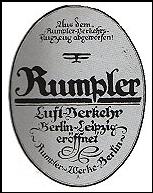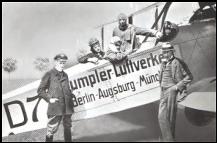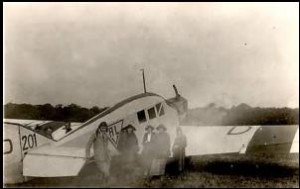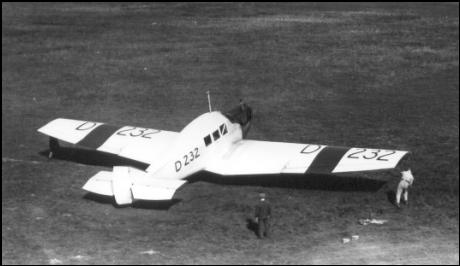By: Rob Mulder
For: www.europeanairlines.no
One of the earliest airline companies in Germany was the airline department of the Bayerische Rumpler-Werke. The aircraft manufacturer was known for its Rumpler C I and Rumpler C IV, built in large numbers during the Great War. After 1919 it entered just as Junkers Flugzeugwerk AG the civil airline business and started up routes in the south of Germany. In 1922 the airline department was reconstructed into an airline company and was by now partially owned by Junkers Flugzeugwerk AG. In January 1926 it became a part of Deutsche Luft Hansa AG.
Bayerische Rumpler-Werke AG, Abteilung Rumpler Luftverkehr (1919-1921)
 The Austrian born engineer Dr Edmund Rumpler formed in 1908 at the centre of German aviation, Berlin-Johannisthal, the Rumpler-Werke AG. In pre-war Germany his far most product was the licence built Etrich-Rumpler-Taube, but due to disagreements with designer, fellow Austrian Igo Etrich, Dr Rumpler was forced to start developing his own products. When the War started in 1914 Rumpler-Werke AG was forced to contribute to the war effort and produce military aircraft of the so-called C-Class, i.e. reconnaissance aircraft. His best product was the C I, which after the Great War would play a major role in the company’s history. In 1916 a daughter company, under the name of Bayerische Rumpler-Werke AG Augsburg was founded and here too aircraft were built under licence, mostly Rumpler C IVs.
The Austrian born engineer Dr Edmund Rumpler formed in 1908 at the centre of German aviation, Berlin-Johannisthal, the Rumpler-Werke AG. In pre-war Germany his far most product was the licence built Etrich-Rumpler-Taube, but due to disagreements with designer, fellow Austrian Igo Etrich, Dr Rumpler was forced to start developing his own products. When the War started in 1914 Rumpler-Werke AG was forced to contribute to the war effort and produce military aircraft of the so-called C-Class, i.e. reconnaissance aircraft. His best product was the C I, which after the Great War would play a major role in the company’s history. In 1916 a daughter company, under the name of Bayerische Rumpler-Werke AG Augsburg was founded and here too aircraft were built under licence, mostly Rumpler C IVs.
After the Great War, the Entente demanded the destruction of the factory at Berlin-Johannisthal, but let the Augsburg factory in tact. Only furniture and other non-aeronautical products were produced here. In 1919 the Berlin company went into liquidation, but continued to live a quiet life. In Germany the company was now known under the name of Rumpler-Werke AG, Berlin-Johannisthal i.L. (i.L. standing for under liquidation).
But under the leadership of Dr Ing Otto Meyer (previous in charge of the production of Rumpler-aircraft in Augsburg) a special department was set up under the name of Rumpler Luftverkehr. By March 1919 it had received from the German Reichsluftamt the fourth civil licence awarded in Germany. The department had at its disposal no less than thirteen Rumpler C I, one Rumpler C IV, two Albatros B IIIs and one Fokker C VIIs. The Rumpler C I (also known as the 5 A 2 or Rumpler-Luft-Limousine) was modified with an enclosed cabin, which could house two passengers. The pilot was sitting between the cabin and the 165hp Benz or Daimler-engine.
 On March 13, 1919 the Rumpler C IV, D 72 made a special flight from Berlin via Gotha to Augsburg. Flights were made in connection with the Leipzig Trade Fair that month and Rumpler Luftverkehr started the air service Berlin – Leipzig and Leipzig – München – Augsburg. Scheduled landings at Nürnberg/Fürth had to be postponed due to the fact that the Entente had not given the airport free. The company continued flying the services with irregularity due to the lack of passengers and the shortage of petrol. Many were still doubtful towards the use of surplus and modified military aircraft. (Two pictures supplied by Horst Zöller).
On March 13, 1919 the Rumpler C IV, D 72 made a special flight from Berlin via Gotha to Augsburg. Flights were made in connection with the Leipzig Trade Fair that month and Rumpler Luftverkehr started the air service Berlin – Leipzig and Leipzig – München – Augsburg. Scheduled landings at Nürnberg/Fürth had to be postponed due to the fact that the Entente had not given the airport free. The company continued flying the services with irregularity due to the lack of passengers and the shortage of petrol. Many were still doubtful towards the use of surplus and modified military aircraft. (Two pictures supplied by Horst Zöller).
Some success was made again during the Leipzig Trade Fair. Between August 31 and September 6, 1919 Rumpler Luftverkehrs aircraft made again extra flights during the fair and offered the Berlin – Leipzig and Leipzig – München – Augsburg air service to the public. During the fair joy ride, commercial and charter flights were made to make extra money. But with the winter ahead all flying activities came to a halt.
During the social unrest in Germany in March 1920 German officers confiscated the Rumpler C IV, D 72 on March 17, but after been used for some flights it was returned to the Rumpler Luftverkehr. Unfortunately the remainder of the fleet was taken by the IAACC, including the Fokker- and Albatros-aircraft. In May a second Air register (in Germany known as the LFR-B) was introduced and all aircraft had to be approved by the IAACC. All aircraft checked and approved for commercial use were then given a star on the fuselage. As one of the exceptions the whole fleet of the Bayerische Rumpler-Werke AG, Abt. Rumpler Luftverkehr were returned. The Commission informed all other airline companies that this approval of use of former military aircraft was an exception and not to be regarded as a precedent.
On June 24, the Rumpler Luftverkehr started with a new type of service: special flights across the Alps. Starting in München and Augsburg, passengers could charter an aircraft for a flight to the Alps. Among other places, landings were made near Garmisch-Partenkirchen and Berchtesgaden in Germany and Innsbruck in Austria. They turned out to be a mixed success. Furthermore, for the fourth time the Rumpler Luftverkehr organised special flights during the Leipzig Trade Fair (August 15-21). Following this success, Rumpler Luftverkehr started to fly during other fairs at Leipzig as well. Both mail, passengers and freight were carried.
The company flew between June and September 1920 the air service Berlin – Leipzig – München – Augsburg. But greater plans were taking shape. The Norddeutscher Lloyd represented the Rumpler Luftverkehr and was interested to start an air service between München and the capital of the new Austrian Republic, Wien. Here the Wiener Flug-Verkehrsgesellschaft m. b. H. had been formed and was supported by the Norddeutscher Lloyd. But on November 5, 1920 the Entente imposed a resolution, forbidding former military aircraft to cross the border. Thus Rumpler C I and Rumpler C IV could not fly to Austria. But in November 1920 the Rumpler Luftverkehr let three Rumpler-aircraft start for a flight to Wien. When the three arrived on 10 November they were confiscated by the French members of the IAACC in Wien and send back to München. Rumpler Luftverkehr and the Norddeutscher Lloyd had to postpone their plans for international air services.
Beside the twice-yearly charter- and joy ride flights during the Leipzig Trade Fair, the Rumpler Luftverkehr continued to operate the Berlin – Leipzig – München – Augsburg air route. Eventually Nürnberg/Fürth could be added on the stretch München – Leipzig. On December 28, 1920 the Entente had given the airport Atzenhof free for air traffic and the Deutsche Luft Lloyd opened the München – Nürnberg/Fürth – Magdeburg – Berlin air route with Rumpler-aircraft. In February 1921 Rumpler Luftverkehr made a trial flight via Nürnberg/Fürth and served the city between May and September, where it made 174 starts with 156 passengers in the direction of Leipzig and Berlin and 164 starts with 142 passengers in the direction of München and Augsburg.
In 1921 the sixteen aircraft of Rumpler Luftverkehr flew 253,796km and carried 701 passengers and 648.5kg mail and freight. Still modest results. But by that time the Rumpler Luftverkehr had the third largest fleet in Germany and was the third largest airline company measured in results.
For the first time some flights over the main trunk route Augsburg – München – Nürnberg/Fürth – Leipzig – Berlin were made during the winter and in February and March 1922 Rumpler Luftverkehr made 23 flights and carried 29 passengers. After this the company continued to operate their regular service and special flights during the Leipzig Trade Fair as before.
But Dr Rumpler was frustrated by the problems he encountered as a result of the restrictions laid upon the German civil aviation as a result of the Treaty of Versailles. Despite an increase in the results in 1922 (1,128 passengers and 125,070km flown) the company was in bad need of capital and needed more modern material. Rumpler himself was not able to produce a successor for his obsolete post-war aircraft and since Junkers Flugzeugwerk AG (Jfa) was eager to break the monopoly of the Norddeutscher Lloyd in Bayern (Bavaria), the two parties found each other and came to an agreement. The air route flown by Rumpler Luftverkehr could connect perfectly with the Junkers’ flown air route to Stettin, Danzig, and Königsberg and further to the Baltic States and Russia.
By September 1922 the negociations between the Bayerische Rumpler-Werke AG and the Jfa could be concluded successfully and a new airline company with decisive Junkers-influence could be formed: the Rumpler Luftverkehr Aktiengesellschaft. The Bayerische Rumpler-Werke AG’s department for aviation was closed down and went up into the new airline company.
Rumpler Luftverkehrs Aktien Gesellschaft
(1922-1926)
The first result of the negociations between Junkers Flugzeugwerk AG (Jfa, represented by Mr Gotthard Sachsenberg and Mr Becker) and Bayerische Rumpler-Werke AG (represented by Dipl Ing Albeck) was reached in August 1922. The Bayerische Rumpler-Werke AG ordered two Junkers F 13s, including engines and spare parts for the price of six million (inflation) Marks. The contract stipulated that the aircraft were not to be brand new, but could have flown a maximum of 20 flying-hours. Delivery was to be latest on August 20. The company took an option on a third aircraft, but this option was not confirmed on the agreed date (September 1, 1922). This contract between the two companies led to a new agreement with regard to a new airline company. The Bayerische Rumpler-Werke AG, Abt. Rumpler Luftverkehr was transformed into an airline company controlled through the board of directors by Jfa. On September 30, 1922 the foundation of the Rumpler Luftverkehr AG took place in München. The founders were:
| Bayerische Rumpler-Werke AG, Augsburg | 375 000 |
| Rumpler-Werke AG i.L., Berlin | 625 000 |
| Dr Otto Schreiber | 15 000 |
| Hermann Aumer | 15 000 |
| Junkers Flugzeugwerk AG, Dessau | 470 000 |
Amounts in Mark.
The total stock-capital was thus Mk.1,500,000 divided over 15,000 shares each worth Mk.100. The two Rumpler-factories paid their share by bringing in six Rumpler C Is and two Junkers F 13s, while the other shareholders paid with cash money. Major a.D. Albert Mühlig-Hofmann, Dipl Ing Albert Albeck and Dr Gottfried Kaumann were appointed as directors. Dr Ing Edmund Rumpler, with Dr Ing Hugo Junkers as vice-president, headed the Board of Directors. The other members were Johann Scherle (from Augsburg), Hermann Aumer (München), Prof. Dr Ing Hugo Junkers (Dessau), Director Hans Sachsenberg (Dessau), Director Gotthard Sachsenberg (Berlin) and Director Friedrich Patze (Berlin). Since the latter four represented the Jfa the Dessau-company had a majority in the Board.
The official aim of the company was the flying of the air service previously flown by Rumpler Luftverkehr, i.e. Augsburg – München, München – Nürnberg/Fürth and Nürnberg/Fürth – Berlin. Furthermore the Rumpler Luftverkehr AG was to participate in other airline company and join partnerships from which it could benefit. The company was reported in to the Trade Register and registered on April 9, 1923.
 Flying activities during the winter were low. During a test flight above München-Schleissheim on March 15, 1923, the Junkers F 13, D 201 Uhu crashed and was destroyed beyond repair. The pilot, Mr Höpken, could save himself with minor scars, but the aircraft was written off. The engine could be used again. (Picture kindly supplied by Tracy Hancock, www.wingsofpeace.net/news/news.html)
Flying activities during the winter were low. During a test flight above München-Schleissheim on March 15, 1923, the Junkers F 13, D 201 Uhu crashed and was destroyed beyond repair. The pilot, Mr Höpken, could save himself with minor scars, but the aircraft was written off. The engine could be used again. (Picture kindly supplied by Tracy Hancock, www.wingsofpeace.net/news/news.html)
If this was not enough the second Junkers F 13, D 206 Zeisig had to make a crash landing near Gersthofen, near Augsburg on June 21, 1923. The aircraft damaged its undercarriage, its wings and the structure holding the engine. Furthermore, the fuselage was slightly pressed. But the aircraft could be repaired and was taken for that purpose to Fürth, were Jfa had a workshop. To replace the lost Junkers F 13, D 201, Rumpler Luftverkehr AG received the D 232, Truthahn in the spring of 1923.
Although the Transeuropa Union – TREU was not officially founded until October 1923, the co-operation as such existed already through the 1923-season. Rumpler Luftverkehr AG had brought into the TREU the Junkers F 13, D 206 and worked together with Ad Astra Aero AG from Switzerland and the Österreichische Luftverkehr AG – ÖLAG. On May 22, 1923 Rumpler Luftverkehr AG/TREU re-opened the München – Nürnberg/Fürth – Dessau – Berlin air service with its Junkers F 13. In München connection was established to and from Switzerland and Austria. The air service was closed down on October 20.
But Rumpler Luftverkehr AG could not fly its regular air service to Leipzig during the Leipzig Trade Fair in March 1923. The reason was that Jfa did not fulfil its earlier promises with regard to support for advertisements. Rumpler Luftverkehr AG itself did not have the financial means to fly and a divided management (there were still offices at both Augsburg and München) worked along each other. It was for Rumpler Luftverkehr AG not possible either to operate regular air services. The company had a debt of 3.6 million Marks and had no money to hire personnel or to buy fuel. Although the company received a credit of Mk.500,000 from the Donauländische Kreditgesellschaft, this money was used to build up the organisation, to purchase office equipment and to buy spare parts for the six Rumpler C I and two Junkers F 13s. Rumpler Luftverkehr AG needed on the short term 30 million (inflation) Marks. The so-called Betriebsgemeinschaft (TREU) was therefore the right solution. But Jfa wanted before founding the TREU to continue with the 1923-season. The two Junkers F 13s of Rumpler Luftverkehr AG were brought into the Transeuropa Union and flew on the air service between München and Berlin. In that way the Rumpler Luftverkehr AG could start earning money, in stead to have to operate an expensive air service by itself. The costs were now divided between the TREU-members.
In 1924 the Rumpler Luftverkehr AG/TREU air service was re-opened on May 1 and flown for the first time all year around. The service started now in Frankfurt am Main and continued to Nürnberg/Fürth and München. In Nürnberg/Fürth the service connected to Dresden and Berlin., while in München passengers could fly to Wien and Budapest. On December 2 the stop in Nürnberg/Fürth was taken out of the schedule, because there was too little daylight left for the aircraft to fly the whole service in one day. As a matter of fact the service was not flown between January and April 20, 1925. Again the Rumpler Luftverkehr AG/TREU flew between München, Nürnberg/Fürth, Dresden and Berlin. The service was suspended on September 30, 1925.
 For the 1925-season, the following aircraft were assigned to the line Berlin – München (Air Service number 6): the Junkers F 13 with the registrations D 454, D 360, D 206 (brought into the TREU (by May 1925 changed in the Europa Union KAG) by Rumpler Luftverkehr AG) and finally D 207. The pilots Dörr, Lieb, Gothe and Eger were used to fly the aircraft. The second Rumpler Luftverkehr AG Junkers F 13, D 232 was used on the service Zürich – Budapest.
For the 1925-season, the following aircraft were assigned to the line Berlin – München (Air Service number 6): the Junkers F 13 with the registrations D 454, D 360, D 206 (brought into the TREU (by May 1925 changed in the Europa Union KAG) by Rumpler Luftverkehr AG) and finally D 207. The pilots Dörr, Lieb, Gothe and Eger were used to fly the aircraft. The second Rumpler Luftverkehr AG Junkers F 13, D 232 was used on the service Zürich – Budapest.
In 1924 the Junkers Luftverkehr AG (Jlag) took over the shares from Junkers Flugzeugwerk AG and these were by 31 December 1924 worth RM.20,000. On May 7, 1925 Rumpler Luftverkehr AG was co-founder of the Europa Union KAG and participated with the minimum of RM.2,000. But when the stock-capital was to be increased in September 1925, Rumpler Luftverkehr AG withdrew and did not participate in the foundation. The situation in German aviation was changing rapidly. The merger of the Jlag and the Deutscher Aero Lloyd AG (DAL) made the foundation of the Europa Union KAG impossible and this led to a change. The TREU was now until December 31, 1925 responsible for the operation of the air services. Both Junkers F 13s of Rumpler Luftverkehr AG remained therefore part of the TREU. Jlags part in the Rumpler Luftverkehr AG had by September 30, 1925 increased to RM.40,000 for each of the aircraft and another RM.16,800 for each engine (Rumpler Luftverkehr AGs Junkers F 13 had BMW-engine number 35 and 107). A total of RM.113,600. When Deutsche Luft Hansa AG was formed, Rumpler Luftverkehr AG joined as well and its part was set to 50% of the above-mentioned amount: a total of RM.56,800. This was eventually reduced to RM. 50,000.
But for 1925 the Rumpler Luftverkehr AG still had a loss of RM 10,341.55 and with the company’s creditors negociations were taken place to come to a settlement. If all aircraft were brought into the Deutsche Luft Hansa AG, the company would loose its only income and increase its debts even further. In July 1926 the directors suggested to liquidate the company and this was agreed upon by the Board of Directors. Beside the two Junkers F 13s, the Rumpler Luftverkehr AG sold it’s remaining Rumpler C I to the Deutsche Luft Hansa AG and went out of business.
